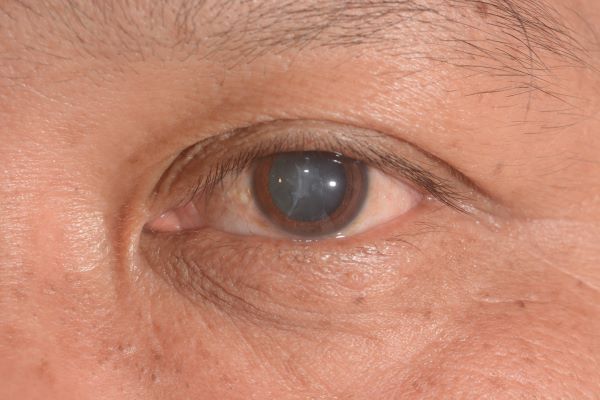ทำความเข้าใจและวิธีการรักษาต้อกระจกและการผ่าตัดต้อกระจก
ต้อกระจกและการผ่าตัดต้อกระจก
ต้อกระจกเป็นภาวะที่เลนส์ตาธรรมชาติเกิดความขุ่นโดยธรรมชาติ ทำให้แสงผ่านเข้าตาได้อย่างจำกัด และส่งผลให้สูญเสียการมองเห็น ในระยะแรกของโรคอาจมีอาการตามัวเล็กน้อยเนื่องจากเลนส์ตาได้รับผลกระทบเพียงบางส่วน ในระยะนี้การรักษาที่พบบ่อยคือ การใช้แว่นตาเพื่อแก้ไขการมองเห็นที่พร่ามัว เมื่อต้อกระจกส่งผลกระทบต่อการมองเห็นอย่างรุนแรง การผ่าตัดถือเป็นสิ่งจำเป็นโดยการนำเลนส์ตาที่ขุ่นมัวออก และแทนที่ด้วยเลนส์แก้วตาเทียม (Intraocular lens) เพื่อให้การมองเห็นกลับมาเป็นเหมือนเดิม1

การผ่าตัดต้อกระจกมี 3 ประเภทหลัก ขึ้นกับสภาวะของดวงตา, เครื่องมือ และอุปกรณ์ทางการแพทย์ของสถานพยาบาล และสถานะทางการเงินของผู้ป่วย โดย 1 ใน 3 วิธีที่มีการแนะนำคือ
- การผ่าตัดต้อกระจกแบบแผลเล็กโดยไม่ใช้เครื่องสลายต้อกระจก (Manual small-incision cataract surgery (MSICS หรือ SICS)) ซึ่งสามารถทำได้ในผู้ป่วยต้อกระจกเกือบทุกประเภท2
- การผ่าตัดสลายต้อกระจก (Phacoemulsification cataract surgery หรือ PCS) เป็นวิธีการผ่าตัดที่นิยมมากที่สุดในปัจจุบัน ซึ่งใช้คลื่นอัลตราซาวน์ที่มีความถี่สูงเพื่อสลายเลนส์ตาที่ขุ่นมัว3
- การผ่าตัดต้อกระจกโดยใช้เลเซอร์ (Femtosecond laser-assisted cataract surgery หรือ FLACS) โดยหลักการพื้นฐานจะคล้ายกับ PCS แต่มีการใช้ลำแสงเลเซอร์เพื่อผ่าตัด และใช้ระบบอัตโนมัติในบางขั้นตอนของการผ่าตัด4
การผ่าตัดต้อกระจก และโรคตาแห้ง
การผ่าตัดต้อกระจกสามารถกระตุ้นให้เกิดอาการตาแห้งได้ เนื่องจากดวงตาเกิดความเสียหาย และทำให้ฟิล์มน้ำตาไม่เสถียรหลังจากทำการผ่าตัด ความรุนแรงของอาการตาแห้งจะมากที่สุด ณ วันที่ 1 หลังการผ่าตัด และจะมีอาการต่อเนื่องเป็นเวลาอย่างน้อย 1-12 เดือนหลังการผ่าตัด5
อกจากนี้ยังพบว่าผู้ป่วยที่เป็นต้อกระจกมักจะมีอาการของโรคตาแห้งอยู่ก่อนแล้ว โดย 50-75% ของผู้ป่วยต้อกระจกจะมีอาการตาแห้งร่วมด้วย และภาวะทั้งสองจะพบได้บ่อยขึ้นตามอายุที่เพิ่มขึ้น6 ผู้ที่มีโรคตาแห้ง หากไม่ได้รับการรักษาอย่างดีก่อนการผ่าตัดต้อกระจก จะส่งผลให้เกิดผลที่ไม่พึงประสงค์ตามมา เช่น การมองเห็นเปลี่ยนแปลงตลอดเวลา เกิดภาวะสายตาผิดปกติ อาการตาแห้งรุนแรงขึ้น และติดเชื้อหลังผ่าตัด เป็นต้น7

ปัจจัยที่ทำให้อาการตาแห้งรุนแรงขึ้นหลังการผ่าตัดต้อกระจก ได้แก่:
การรักษาโรคตาแห้งก่อน และหลังการผ่าตัดต้อกระจก
สำหรับผู้ที่เป็นโรคตาแห้งก่อนการผ่าตัด จำเป็นต้องมีการปรับแนวทางการรักษาให้เหมาะสม ซึ่งรวมถึงการใช้น้ำตาเทียมที่มีจำหน่ายทั่วไป โดยไม่ต้องใช้ใบสั่งยาจากแพทย์ และใช้ใบสั่งยาจากแพทย์ ผู้ป่วยที่มีโรคทางตาอื่นๆ เช่น ต่อมไขมันที่เปลือกตาทำงานผิดปกติ อาจได้รับประโยชน์จากการดูแลก่อนการผ่าตัดซึ่งประกอบด้วยการประคบอุ่น การทำความสะอาดเปลือกตา และการรักษาไรที่ขนตา (Demodex)16 นอกจากนี้มีความเชื่อว่าการรักษาอาการตาแห้งทั้งก่อน และหลังการผ่าตัดด้วยการใช้ยาหยอดตาที่มีคุณสมบัติเป็นสารหล่อลื่น รวมถึงเจล และขี้ผึ้งป้ายตา จะช่วยบรรเทาอาการตาแห้ง ช่วยให้การมองเห็นดีขึ้น และเพิ่มความพึงพอใจโดยรวมแก่ผู้ป่วยที่ได้รับการผ่าตัดต้อกระจก17 ผู้ป่วยที่มีอาการตาแห้งอย่างรุนแรงสามารถพิจารณาการรักษาแบบการอุดท่อน้ำตาได้ ซึ่งจะเป็นอุปกรณ์ที่ใส่เข้าไปบริเวณท่อน้ำตาเพื่อยับยั้งการระบายออกของน้ำตาและรักษาความเสถียรของผิวดวงตาไว้18
สำหรับผู้ที่มีอาการตาแห้งหลังการผ่าตัดต้อกระจกร่วมกับการรักษาอื่นๆ ที่กล่าวไว้ข้างต้น อาจพิจารณาวิธีการดังต่อไปนี้:

- Sodeman, W.A. and Sodeman, T.C. "Cataracts: Patient and Caregiver's Guide". Instructions for Geriatric Patients (3rd edition). W.B. Saunders. 2005.
- Jha, K.N. and Vats, D.P. Manual Small Incision Cataract Surgery: Experience at a Military Hospital. Medical Journal Armed Forces India 2006;62(3):212-215.
- Linebarger, E.J., et al. Phacoemulsification and Modern Cataract Surgery. Survey of Ophthalmology. 1999;44(2):123-147.
- Roberts, H.W., et al. A randomized controlled trial comparing femtosecond laser– assisted cataract surgery versus conventional phacoemulsification surgery. Journal of Cataract and Refractive Surgery 2019;45(1):11-20.
- Miura, M., et al. Prevalence and Characteristics of Dry Eye Disease After Cataract Surgery: A Systematic Review and Meta-Analysis. Ophthalmology and Therapy 2022;11(4):1309-1332.
- Don't Let Dry Eye Derail Cataract Surgery. American Academy of Ophthalmology. https://www.aao.org/eye-health/tips-prevention/dry-eye-cataract-surgery-ocularsurface-disease (Accessed 2023-04-06).
- Starr, C.E., et al. An algorithm for the preoperative diagnosis and treatment of ocular surface disorders. Journal of Cataract and Refractive Surgery 2019;45(5):669-684.
- Kim, J.H., et al. Change in Corneal Sensitivity and Corneal Nerve after Cataract Surgery. Cornea 2009;28(11):S20-S25.
- Rosenthal, P., et al. Oculofacial Pain: Corneal Nerve Damage Leading to Pain Beyond the Eye. Investigative Opthalmology & Visual Science 2016;57(13): 5285-5287.
- Hwang, H.B. and Kim H.S. Phototoxic Effects of an Operating Microscope on the Ocular Surface and Tear Film. Cornea 2014;33(1):82-90.
- Kato, K., et al. Management of Postoperative Inflammation and Dry Eye After Cataract Surgery. Cornea 2019;38(1):S25-S33.
- Li, X.-M., et al. Investigation of Dry Eye Disease and Analysis of the Pathogenic Factors in Patients after Cataract Surgery. Cornea 2007;26(Suppl. 1):S16-S20.
- Yu, Y., et al. Evaluation of dry eye after femtosecond laser–assisted cataract surgery. Journal of Cataract and Refractive Surgery 2015;41(12):2614-2623.
- Chen, W.-T., et al. Dry Eye Following Femtosecond Laser-Assisted Cataract Surgery: A Meta-Analysis. Journal of Clinical Medicine 2022;11(21):6228.
- Ishrat, S., et al. Incidence and pattern of dry eye after cataract surgery. Saudi Journal of Ophthalmology 2019;33(1):34-40.
- Song, P., et al. Preoperative Management of MGD Alleviates the Aggravation of MGD and Dry Eye Induced by Cataract Surgery: A Prospective, Randomized Clinical Trial. BioMed Research International 2019;2019:1-10.
- Ganesh, S., et al. Topical Cyclosporine (0.05%) for Management of Dry Eyes in Patients Undergoing Cataract Surgery-A Comparative Study. The Open Ophthalmology Journal 2019;13(1):34-42.
- Gayton, J. Etiology, prevalence, and treatment of dry eye disease. Clinical Ophthalmology 2009;3:405-412.
- Jee, D., et al. Comparison of treatment with preservative-free versus preserved sodium hyaluronate 0.1% and fluorometholone 0.1% eyedrops after cataract surgery in patients with preexisting dry-eye syndrome. Journal of Cataract and Refractive Surgery 2015;41(4):756-763.
- Alio, J.L., et al. Treatment of Dry Eye Disease with Autologous Platelet-Rich Plasma: A Prospective, Interventional, Non-Randomized Study. Ophthalmology and Therapy 2017;6(2): 285-293.
- Wu, X., et al. Efficacy of bandage contact lens for the management of dry eye disease after cataract surgery. International Ophthalmology 2021;41(4):1403-1413.
Five‐item Dry Eye Questionnaire (DEQ-5).









